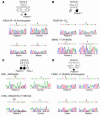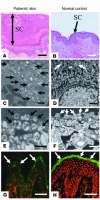Mutations in lipid transporter ABCA12 in harlequin ichthyosis and functional recovery by corrective gene transfer
- PMID: 16007253
- PMCID: PMC1159149
- DOI: 10.1172/JCI24834
Mutations in lipid transporter ABCA12 in harlequin ichthyosis and functional recovery by corrective gene transfer
Abstract
Harlequin ichthyosis (HI) is a devastating skin disorder with an unknown underlying cause. Abnormal keratinocyte lamellar granules (LGs) are a hallmark of HI skin. ABCA12 is a member of the ATP-binding cassette transporter family, and members of the ABCA subfamily are known to have closely related functions as lipid transporters. ABCA3 is involved in lipid secretion via LGs from alveolar type II cells, and missense mutations in ABCA12 have been reported to cause lamellar ichthyosis type 2, a milder form of ichthyosis. Therefore, we hypothesized that HI might be caused by mutations that lead to serious ABCA12 defects. We identify 5 distinct ABCA12 mutations, either in a compound heterozygous or homozygous state, in patients from 4 HI families. All the mutations resulted in truncation or deletion of highly conserved regions of ABCA12. Immunoelectron microscopy revealed that ABCA12 localized to LGs in normal epidermal keratinocytes. We confirmed that ABCA12 defects cause congested lipid secretion in cultured HI keratinocytes and succeeded in obtaining the recovery of LG lipid secretion after corrective gene transfer of ABCA12. We concluded that ABCA12 works as an epidermal keratinocyte lipid transporter and that defective ABCA12 results in a loss of the skin lipid barrier, leading to HI. Our findings not only allow DNA-based early prenatal diagnosis but also suggest the possibility of gene therapy for HI.
Figures






Comment in
-
Harlequin ichthyosis unmasked: a defect of lipid transport.J Clin Invest. 2005 Jul;115(7):1708-10. doi: 10.1172/JCI25736. J Clin Invest. 2005. PMID: 16007249 Free PMC article. Review.
References
-
- Williams ML, Elias PM. Genetically transmitted, generalized disorders of cornification; the ichthyoses. Dermatol. Clin. 1987;5:155–178. - PubMed
-
- Judge, M.R., McLean, W.H.I., and Munro, C.S. 2004. Disorders of keratinization. In Rook’s textbook of dermatology. 7th edition. T. Burns, S. Breathnach, N. Cox, and C. Griffiths, editors. Blackwell Publishers. Oxford, United Kingdom. 34.1–34.111.
-
- Allikmets R, Gerrard B, Hutchinson A, Dean M. Characterization of the human ABC superfamily: isolation and mapping of 21 new genes using the expressed sequence tags database. Hum. Mol. Genet. 1996;5:1649–1655. - PubMed
-
- Dean M, Rzhetsky A, Allikmets R. The human ATP-binding cassette (ABC) transporter superfamily. Genome Res. 2001;11:1156–1166. - PubMed
-
- Borst P, Elferink RO. Mammalian ABC transporters in health and disease. Annu. Rev. Biochem. 2002;71:537–592. - PubMed
Publication types
MeSH terms
Substances
LinkOut - more resources
Full Text Sources
Other Literature Sources
Medical
Molecular Biology Databases

